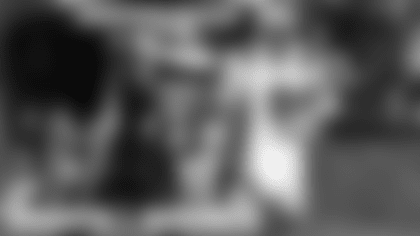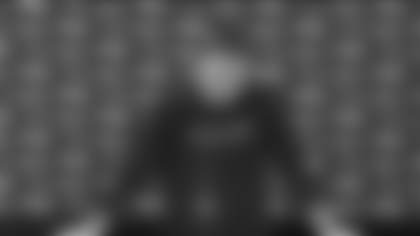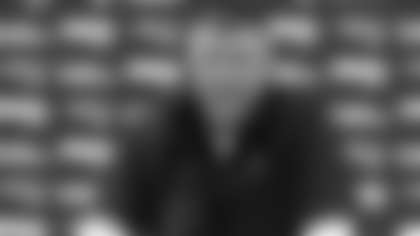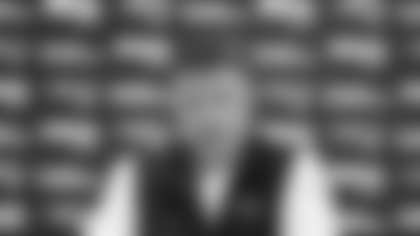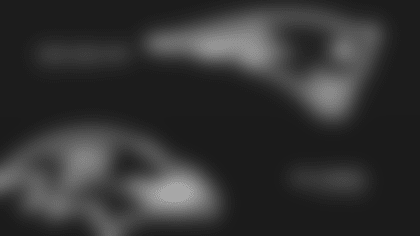BB: We've got the hardcore here. How's it going? We'll hopefully be ready to roll here by Sunday.
Q: How much did you get to see Byron Jones in the spring?
BB: Yeah, he's a good player – big, fast, tackles well. He does a good job. He's got corner-safety flexibility. They also use him down by the line of scrimmage. They put him on [Benjamin] Watson last week. So, he's a versatile guy. He's got some length.
Q: When you acquire a guy during the season, how much of that is based on how quickly he can adjust to your system and pick things up quickly?
BB: Having them know what to do to be able to get out on the field is important. We've got to do a good job of teaching it, obviously condensing or streamlining information because you can't get the whole playbook in, and they've got to do a good job of working hard to learn it and specifically learn that game plan, so a lot of times you really try to get them on the game plan first and then the next week you get the next game plan but maybe you can start to add some things to it and eventually over time be able to catch up on the overall nomenclature, terminology, more of a comprehensive understanding. And that varies from player to player, too – how experienced they are, how much experience they've had in a system similar to ours or things that they can relate or where there is carryover. Each one is a little bit different. Each of us learns differently. Some things we pick up quicker than others, so it is really very individualized between that player and whichever staff members and his position coach are a part of that, getting him up to speed, covering what he needs to know for that game, but also getting him acclimated into all the other aspects of our program, too – not just the plays, but there are a lot of other things they need to learn or fall in line with.
Q: With respect to that, what have you seen from the development of Justin Coleman?
BB: Definitely making progress. It's hard for any player when they miss training camp, so there is a lot of ground there that just really never gets made up. You just try to close the gap as much as you can. But it's definitely getting better. Each week it gets better and there is more carryover – kind of what we just talked about. But yeah, he's definitely making good progress. There is just a long way to go. It's a big gap.
Q: A lot of times, a player has to adjust his technique when he comes into your system. How difficult has that transition been for Justin Coleman?
BB: I'd say not too bad, yeah, not too bad. You have your golf swing and then you go somewhere else and they change your swing – sometimes it's easier, sometimes it's harder. He's done a good job. I don't think it's been a big adjustment for him. We play a lot of … Our corner techniques are closer to the line of scrimmage – not all of them but a lot of them – so that was something that he needs to work on a little bit. But he's done that. His athletic skills I think are good for what we've asked him to do, so I wouldn't say that's a big problem. We go over some communication, some adjustments in our system, and anytime you have to do a lot of thinking or you're unsure as to is it this or is it that, that slows you down no matter how fast you are. I think that that's making an improvement. He's made a lot of improvement there and that enables him play faster, play more aggressively and play more confidently. That just gets better every day.
Q: How does Jabaal Sheard's versatility strengthen that position?
BB: A lot. Jabaal has done a really good job for us, and he plays on all three downs, so he can play the run well, he's strong, he uses his hands well, he's got good length, he can rush, he's rushed inside, rushed outside, played on the tackle, played on the tight end, played some in there on the guard and some in coverage on certain adjustments we have or certain calls. He's done a good job. That's something you didn't really get to see him do in Cleveland. He pretty much always played one spot, left end, pretty much the same technique most of his career. So seeing him do different things and being able to adapt to them and as you said create depth and versatility for us has been a big plus for him and for us. It's been good.
Q: What have you seen from Dallas' running game with the Joseph Randle-Darren McFadden duo instead of DeMarco Murray?
BB: Good, well it's been a lot of Randle. They've used McFadden a little bit as a change of pace guy, but he's certainly a quality player, has got good size, runs well, can attack the perimeter of the defense and he's got the power to get downhill. They have very talented backs. [Christine] Michael, the kid they got from Seattle is another one. I know he didn't play a lot last week, but I'm sure they traded for him because they have plans for him, so I'm sure he'll be showing up in there if not this week then soon, so we've got to be ready for him, too. [Lance] Dunbar gave them a lot of production in the passing game, but they have good depth at that position.
Q: How does Dallas' great offensive line show up on the field? Are they able to do things other teams can't?
BB: No, I don't think that's really their thing. I mean, Coach [Scott] Linehan mixes things up, so there is some of it. I would say they do a good job of getting the backs started in the running game. They don't have a lot of penetration; there aren't very many negative plays. They're usually able to get the back into the line of scrimmage and get them going and it's up to them, whether it's Murray last year or Randle this year, those guys once they get in there make a lot of yards on their own, like the Atlanta run. So, they're physical, they play well together, the combination blocks, zone blocks, double-team blocks. [Zack] Martin is good, [Travis] Frederick is very athletic in there at center, big strong guy in [Ronald] Leary, [Tyron] Smith is as good as come, [Doug] Free has done a good job for them, [Jason] Witten is an excellent blocker. He's part of that offensive line in the running game. He's probably as good as we'll face. He's very experienced. He knows how to work it. So, you're not just worried about him getting into the pattern, but he's good at the point of attack in the running game. They move him some, so sometimes he's on the move or you can't really set your defense to him because at times he'll change spots on you and then you have to relocate it. But it's a very efficient group. They play [La'el] Collins in there a little bit and the kid from Bentley [Mackenzy Bernadeau] who's name I can't pronounce. They've all played a little bit of left guard when Leary was hurt. But they've got good depth there and they've got good, quality players – three first-round picks – and really Collins without his pre-draft incident this year probably would have been in the first round, too. I know he's a free agent, but it's really kind of four first-round picks, which is a lot at that position. You don't usually see that, especially drafted by the same team. You might get a guy or two from another team later on down the line, but they've made a conscious effort to build that position, and it's really paid off for them.
Q: With Tyron Smith, is it his length that makes him so good?
BB: It's everything. He's really good – long, athletic, power, good run blocker, good pass blocker, hard to get around, good finisher. He seems like a great kid, works hard, very dedicated guy, off the field brings leadership to them, brings toughness. He does a good job.
Q: In the 1950's and 1960's, Tom Landry came up with the shift on the offensive line. What was the point of that back then?
BB: Basically what they did was they gave each player, tight end, well actually every player, they had different spots, so it could be like eight, nine, 10 spots they could line up in, and when they double shifted, which they usually did, then the player had to line up within two spots of where he was going to end up. So, the first time he could shift from A to B and then B to C, where he was going to end up, or from C to B back to C or wherever. And so when the line went up and went down, that was just another distraction and I'd say temporary loss of some vision for the defense to recognize where the back was. I'd say back when Coach Landry put it in, most all plays were two-back sets, so it was basically three formations – red, brown and blue, strong backs, weak backs and split backs. Then eventually we got into the I-formation in the 70's, so that was kind of the fourth position, and every once in a while, you'd have a guy up on the wing in a one-back set, but that wasn't that common. But the tendencies from those formations – I, strong backs, weak backs and split backs, on every team were I would say pretty strong in those days, depending on who the players were and the scheme, but they were still pretty strong. Strong backs, there was a lot of running strong side, weak backs, a lot of running to the weak side, split backs, a lot of running to the strong side, a lot of passing. So, there were a lot of strong tendencies. I think Coach Landry's idea probably was to keep those tendencies from being recognized until as late as possible by the defense and force the defense to communicate, like, 'We're doing this on brown, we're doing this on blue, we're doing this on red,' so we're this to that, this to that and the ball is snapped, so you don't really have time to get into your adjustments if you have any or even your final recognition, where good players that were prepared – here's what they do out of brown, here's what they do out of blue, here's what they do out of red – but it's red to brown to blue, and boom. But that line up and down was a little bit of a distraction – not distraction, but it just blocked the vision a little bit of the linebackers from recognizing exactly where everybody was until they went back down. They go on some quick counts, so it would force you to declare if you were going to do anything because they might snap it with everybody in a two-point stance, but most of the time they were up and down, and it gave the quarterback a little bit more time to watch the defense and see where they were going to go. When Ed Hughes came to Detroit – Ed Hughes was the running backs coach for Coach Landry a number of years down there – when he came to Detroit in 1977 when I was there and I coached the receivers that year, so I learned that offense. That was kind of the offense that we installed that year and ran, so it was pretty interesting. It was only one year, but it was pretty interesting to learn the Dallas offensive system because very few people left Dallas. That staff stayed together. There wasn't a lot of movement out of there, so it was pretty interesting to learn the way that it was written, the way it was presented, the coaching points, how different plays fit off each other.
Q: How come you don't see it anymore?
BB: There are a lot of things you don't see anymore. First of all, it was a pretty complex scheme, so if you weren't well versed in it, that's not the kind of thing you just pick up and say, 'Oh gee that looks good – why don't we start running some of that?' I think you've got to really know it and know all of the nuances to it and understand how it all fits together because it was protections, it was routes, it was the volume of offense because they were together for so long. It was kind of like Paul Brown's offense that he developed that then eventually [Bill] Walsh built on, but after not years, but decades, a couple decades really of running the same thing, you build up a lot of volume, but there is a reason for everything and each play has a complement and if you're not really in that system, I think it'd be hard to start it up somewhere else. You'd probably start up what you've been familiar with and what you know rather than jump into something that's as intricate as that. Same thing with the flex defense – unless somebody left there, like when Coach [Gene] Stallings left, but you didn't really see anybody else doing that because I don't know if anybody really understood it or maybe they didn't believe in it or whatever. But they didn't know it well enough to coach it and install it like Dallas did.
Q: It's much more of a gimmick in your eyes, though?
BB: I don't think any of their things were gimmicks. I think there was a lot of thought into all of them. There was a reason for everything. The hard thing for us in Detroit that year in '77 was trying to get to the point where the Dallas offense was after 15 years or whatever it was in one year. It was impossible. You have to pick out a few things, try to get good at those, build on those. But the Dallas offense after years and years and years and years of coaching it, drafting players into it, developing it, doing all of the things they did with it and then you try to run it, you're a long way from being where they are on a lot of levels. Even if you have good talent, it's still the system was pretty involved. It was a great learning experience for me. I learned a ton. It was something that prior to, I had never been involved with obviously and since then haven't. I'm not saying I understand it but at least I've coached it. I understand some of the principles of it, whether we actually run those plays or not. But the principles that were involved, what they tried to do was very, very educational. I was taking a graduate course in that, which along the same lines, in addition to, but I also learned a lot about the flex defense. Even though we didn't run it, the fact that Ed had come from Dallas, kind of had the Dallas system, we were able to talk about it. He understood what they were doing. That was also very educational. I was fortunate my first few years in the league. I worked for a lot of different coaches, worked with a lot of different assistant coaches, worked in different systems, worked in different cities, a lot of different players, different organizations, so I got a lot of exposure – a lot more than I wanted – but I got a lot of exposure in a short amount of time to a lot of football. In the end that's not a bad thing. Wasn't that great at the time, but in the end it turned out to be beneficial.
Q: What does Rolando McClain bring to the table and what does his return mean for the Dallas defense?
BB: He's a good football player. He played well for them last year in the middle. He's a very athletic guy, has got good size for an inside linebacker. He's a tall guy. He's a guy who runs well. He's big, he's fast, he's very smart, he understands defenses well, can handle controlling the front seven – I don't think that's any problem for him. He's a tough guy. He's a good tackler. He's another good football player. I think [Anthony] Hitchens has done a good job for them. He played outside last year, actually played all three spots last year, so it just gives them more depth at that position. Obviously [Sean] Lee is a good player. Last week they played [Kyle] Wilbur more down than up. He's played up for them. [Andrew] Gachkar is a guy that played at San Diego and has done a good job of moving into the situation there. They drafted [Damien] Wilson. He's another quality player that gives them good depth there. It's just another good player.
Q: News came out yesterday that you guys signed Dion Lewis to an extension. What have you seen from him off the field that made you want to make that commitment?
BB: I think off the field Dion has been great. Had a really good offseason for us, works hard, is a well-conditioned player, trains hard, he's strong, he does a very good job of really knowing … The volume we have on offense is extensive. He's done a good job of learning obviously all the running back stuff, but extended plays, empty plays, things like that where he's playing out of the backfield, various things. He did a good job for us in the kicking game. We could use him as a kickoff returner. Danny [Amendola] has done a good job for us there, too. We have some other options, but he's shown value in the kicking game, shown value on all three downs on offense. He does a good job of learning. He's learned a lot of different spots, a lot of different adjustments – all the different blitz pickups and so forth in the passing game – so he's picked things up well. He works hard. He's tough. He's here every day. Very coachable, just really tries to do what you ask him to do, whatever it is he just doesn't ask any questions, he just works hard to get it right. You love to coach guys like that.
Q: You guys have had running backs in the past that make yards in a similar kind of way with shiftiness. How unique is Dion's ability to start and stop?
BB: He's got good short-area quickness, good change of direction. I think for his size, he's got good power. He's never going to be a 240-pound power back, but for his size he's got good power and explosiveness. You see him put his shoulder down and pick up a couple extra yards or run through those light tackles, as well as his ability to make guys miss in space and change direction. He's got a number of ways he can get extra yards and his ability to catch the ball, his ability to run inside and outside gives you a lot of options with a guy like that in the game. He makes the most out of what he's got. He's got a good skill set. It's not the same as other guys, but he can make his work and he's done it on a number of different levels – first down, second down, third down, running game, passing game, inside, outside, kick returns. He's got a lot to work with there.




